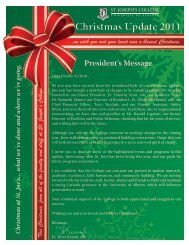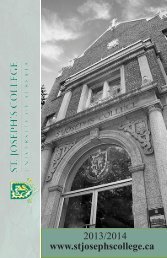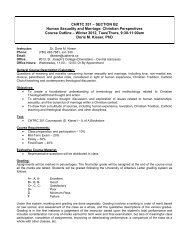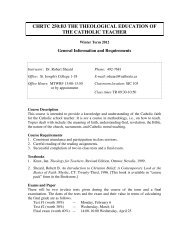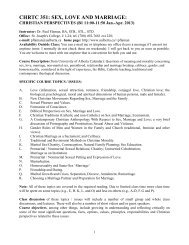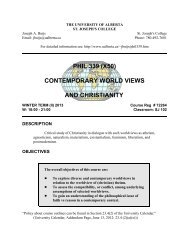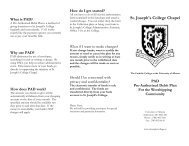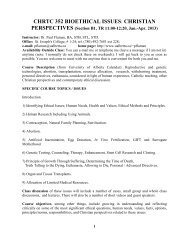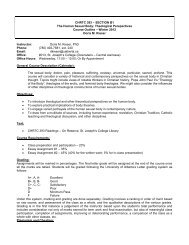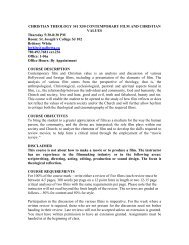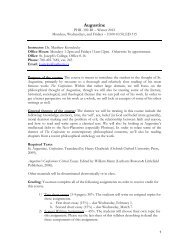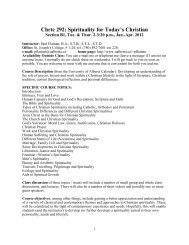chrtc 250:b3 the theological education of the catholic teacher
chrtc 250:b3 the theological education of the catholic teacher
chrtc 250:b3 the theological education of the catholic teacher
You also want an ePaper? Increase the reach of your titles
YUMPU automatically turns print PDFs into web optimized ePapers that Google loves.
CHRTC <strong>250</strong>:B3 THE THEOLOGICAL EDUCATION OFTHE CATHOLIC TEACHERWinter Term 2013General Information and RequirementsInstructor: Dr. Ayodele Ayeni, C.S.Sp. Phone: 780-237-1138Office: St. Joseph's College 1-18Office Hours: By appointment 13:00-13:50E-mail: aayeni@ualberta.caClassroom location:Class times MWF 12:00-12:50Course DescriptionThis course is intended to provide a knowledge and understanding <strong>of</strong> <strong>the</strong> Catholic faith for <strong>the</strong>Catholic school <strong>teacher</strong>. It is not a course in methodology, i.e., on how to teach. Topics dealtwith include: <strong>the</strong> meaning <strong>of</strong> faith, understanding God, revelation, <strong>the</strong> Bible, <strong>the</strong> nature <strong>of</strong> <strong>the</strong>church, sacraments, and Catholic moral teaching.Course Requirements1. Consistent attendance and participation in class sessions.2. Careful reading <strong>of</strong> <strong>the</strong> reading assignments.3. Successful completion <strong>of</strong> two in-class tests and a final exam.Textbooks1. Knox, Ian. Theology for Teachers. Revised Edition. Ottawa: Novalis, 1999.2. Sheard, Robert B. An Introduction to Christian Belief: A Contemporary Look at <strong>the</strong> Basics<strong>of</strong> Faith. Mystic, CT: Twenty-Third, 1996. [This book is available in “course pack” form in<strong>the</strong> Bookstore.]Exams and PaperThere will be two in-class tests given during <strong>the</strong> course <strong>of</strong> <strong>the</strong> term and a final examination. Thedates <strong>of</strong> <strong>the</strong> tests and <strong>the</strong> exam and <strong>the</strong>ir value in terms <strong>of</strong> calculating <strong>the</strong> final grade are asfollows.Test #1 (worth 30%) — Monday, February 6Test #2 (worth 30%) — Wednesday, March 14Final exam (worth 40%) — 14:00-16:00 Wednesday, April 25Remarks on Grading
1. In grading answers to <strong>the</strong> two exams, a "raw score" mark is first given. This is a numberbetween 0 and 15, with 0 being <strong>the</strong> lowest and 15 being <strong>the</strong> highest possible. A raw scoremark <strong>of</strong> 8 is given to answers that one should expect from a normal university student.2. The raw score marks assigned to each answer <strong>of</strong> an exam are totaled and this total isconverted into a letter-grade/percentage mark. See <strong>the</strong> Table below for <strong>the</strong> conversionsand interpretation <strong>of</strong> <strong>the</strong> letter-grades.3. At <strong>the</strong> end <strong>of</strong> <strong>the</strong> term, a final letter-grade/percentage mark will be calculated according to<strong>the</strong> weight given to each exam and to <strong>the</strong> paper. It is important to note, however, that <strong>the</strong>final grade may not necessarily be based on <strong>the</strong> ma<strong>the</strong>matical calculation <strong>of</strong> grades receivedon <strong>the</strong> two exams and <strong>the</strong> paper. O<strong>the</strong>r factors, such as class participation andimprovement during <strong>the</strong> term may affect <strong>the</strong> final mark.Table for Converting Raw Score Marks into Letter Grade and Percentage Marks45 A+ 100 Exceptional 26 C+ 69 Good44 A+ 95-99 25 C+ 6843 A+ 93-94 24 C+ 6742 A+ 90-9223 C 66 Satisfactory41 A 89 Excellent 22 C 6540 A 87-88 21 C 6439 A 8638 A 85 20 C- 6319 C- 6237 A- 82-84 18 C- 60-6136 A- 80-8117 D+ 59 Pass35 B+ 79 Very Good 16 D+ 5834 B+ 78 15 D+ 5733 B+ 7714 D 5632 B 76 13 D 5531 B 75 12 D 5430 B 7411 D- 53 Unsatisfactory29 B- 73 Good 10 D- 5228 B- 72 9 D- 50-5127 B- 70-71
Course outline policy:“Policy about course outlines can be found in ' 23.4(2) <strong>of</strong> <strong>the</strong> University Calendar.”(GFC 29 SEP 2003).“The University <strong>of</strong> Alberta is committed to <strong>the</strong> highest standards <strong>of</strong> academic integrity andhonesty. Students are expected to be familiar with <strong>the</strong>se standards regarding academic honestyand to uphold <strong>the</strong> policies <strong>of</strong> <strong>the</strong> University in this respect. Students are particularly urged t<strong>of</strong>amiliarize <strong>the</strong>mselves with <strong>the</strong> provisions <strong>of</strong> <strong>the</strong> Code <strong>of</strong> Student Behaviour (online atwww.ualberta.ca/secretariat/appeals.htm) and avoid any behaviour which could potentiallyresult in suspicions <strong>of</strong> cheating, plagiarism, misrepresentation <strong>of</strong> facts and/or participation in an<strong>of</strong>fence. Academic dishonesty is a serious <strong>of</strong>fence and can result in suspension or expulsionfrom <strong>the</strong> University.” (GFC 29 SEP 2003)In resolving any discrepancy between this course outline, syllabus or course website, GFC policyand Calendar regulations will take precedence. (GFC 29 SEP 2003)Academic OffencesBecause <strong>of</strong> <strong>the</strong> seriousness <strong>of</strong> plagiarism and cheating, please note <strong>the</strong> definitions <strong>of</strong> cheatingand plagiarism and <strong>the</strong> related penalties. The Code <strong>of</strong> Student Behaviour is published in <strong>the</strong>Calendar (pages 743-763) and should be reviewed since ignorance is not acceptable as adefence in cases <strong>of</strong> academic <strong>of</strong>fences. When cheating and/or plagiarism occurs, a number <strong>of</strong>sanctions can be imposed, such as lowering a grade or expulsion from <strong>the</strong> University (outlinedin Section 30.4.2 <strong>of</strong> <strong>the</strong> Code). Academic integrity is important. In examinations, it is particularlyimportant to note that texts and notes are not permitted in places that might promotecheating.Please note Section 30.3.2 in “Extract from <strong>the</strong> Code <strong>of</strong> Student Behaviour” is available from <strong>the</strong>GFC Policy Manual and <strong>the</strong> copy <strong>of</strong> “Notice to Instructors regarding Plagiarism and Cheating(Cheatsheet)” is available at http://www.ualberta.ca/secretariat entitled “Don’t Cheat Sheet”..A copy <strong>of</strong> <strong>the</strong> Code <strong>of</strong> Student Behaviour may be obtained from <strong>the</strong> University Secretariat website: http://www.ualberta.ca/secretariat.In particular, please note:No student shall represent ano<strong>the</strong>r’s substantial editorial or compositional assistance on anassignment as <strong>the</strong>ir own.No student shall submit in any course or program <strong>of</strong> study, without <strong>the</strong> written approval <strong>of</strong> <strong>the</strong>course instructor, all or a substantial portion <strong>of</strong> any academic writing, essay, <strong>the</strong>sis, researchreport, project assignment, presentation or poster for which credit has been obtained by <strong>the</strong>Student or which has previously been or is being submitted by <strong>the</strong> Student in ano<strong>the</strong>r course orprogram <strong>of</strong> study in <strong>the</strong> University or elsewhere.
COURSE OUTLINE AND READINGSINTRODUCTIONPART ONE. FOUNDATIONS: FAITH AND GOD1. Towards An Understanding <strong>of</strong> Religious FaithReading: Theology for Teachers, chs. 1, 2, 5Introduction to Christian Belief, ch. 1.2. Towards An Understanding <strong>of</strong> GodReading: Theology for Teachers, chs. 3 & 4.Introduction to Christian Belief, ch. 2.PART TWO. FOUNDATIONS: REVELATION, SCRIPTURE, AND TRADITION3. Revelation: Our Contact With GodReading: Theology for Teachers, ch. 6.Introduction to Christian Belief, ch. 3.4. God’s Word in Scripture And TraditionReading: Theology for Teachers, ch. 7.Introduction to Christian Belief, chs. 4 & 5.5. The Old TestamentReading: Theology for Teachers, chs. 8 & 9.6. The New TestamentReading: Theology for Teachers, ch. 10.PART THREE. TOWARDS AN UNDERSTANDING OF JESUS7. Understanding Jesus <strong>of</strong> NazarethReading: Theology for Teachers, ch. 11.Introduction to Christian Belief, chs. 10. 11, 12, 13, 14, & 15.PART FOUR. CHURCH AND SACRAMENT8. Towards an Understanding <strong>of</strong> <strong>the</strong> ChurchReading: Theology for Teachers, chs. 12 & 13.9. Sacramentality and SacramentsReading: Theology for Teachers, chs. 14, 15, 16.



